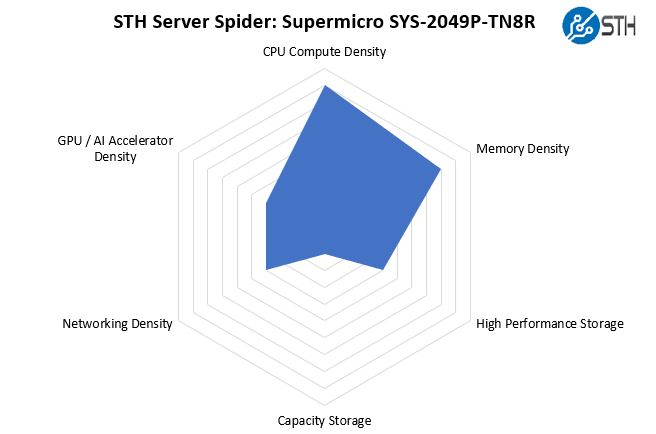Supermicro 2049P-TN8R Power Consumption
For this, we wanted to present two sets of numbers. One using the four Intel Xeon Gold 6252 processors without storage being used, and then a maximum effort run with both storage and networking being hammered along with the CPU. We thought it would be important to give a range.
- Idle: 0.25kW
- STH 70% CPU Load: 0.82kW
- 100% Load: 1.0kW
- Maximum Recorded: 1.2kW
That is a great overall showing since it is relatively power efficient versus running separate nodes. This is about 70W less than we saw from running two Xeon Gold 6252 nodes which makes sense since you are using the power supplies more effectively and not duplicating boot drives, BMCs, and other features. The 2.2kW power supplies are clearly enough to handle this load while leaving the headroom to utilize higher power PCIe expansion devices.
Note these results were taken using a 208V Schneider Electric / APC PDU at 17.5C and 71% RH. Our testing window shown here had a +/- 0.3C and +/- 2% RH variance.
STH Server Spider: Supermicro 2049P-TN8R
In the second half of 2018, we introduced the STH Server Spider as a quick reference to where a server system’s aptitude lies. Our goal is to start giving a quick visual depiction of the types of parameters that a server is targeted at.

As we saw in our teardown, this server is designed specifically to offer a dense 2U 4-socket server platform with a full set of 48 DIMMs in a shorter depth sub-31″ chassis. It sacrifices storage and expansion capabilities to do this. For the scale-out 4-socket market, this type of trade-off makes a lot of sense.
Final Words
While many 4-socket offerings from Supermicro, as well as other vendors, attempt to be the most flexible, there is a downside. Flexibility adds cost and rack footprint. Against that backdrop, the Supermicro 2049P-TN8R is a refreshing departure. Its relentless focus on minimizing extraneous features that are simply not needed in this usage model shows just how much can be done.
Before purchasing this system, a buyer needs to be aware of the trade-offs. This does not have a vast storage subsystem. Likewise, it does not have provisions for flexible risers nor full-height expansion cards. There is a single 1GbE port instead of two or more we commonly see on Supermicro servers. Those trade-offs are exactly the point of the 2049P-TN8R.
While this is not a solution for every deployment, it is one that makes a lot of sense for those in a specific usage scenario. For scale-out 4-socket deployments, the Supermicro 2049P-TN8R is purpose-built to deliver high levels of efficiency while minimizing cost.




Can Supermicro get STH a JBOF to connect to this to test? That’d be a neat combo.
Any tests planned vs. a 2P EPYC Rome system? Would be good to see the performance and power comparisons.
Hi MoreServersPlease. In these reviews, we focus on options that one can configure in the platform being reviewed. You may be looking for the CPU review which we published here: Quad Intel Xeon Gold 6252 Benchmarks and Review
Why exactly 3would anyone even think of using Xeon thesee days ?
It has more security holes than a swiss cheese, it’s relatively highly priced and with uncertain upgrade path.
What’s the point ?
Brane2: you can’t probably have number of DIMMS available in this system in any even dual cpu Epyc system. Otherwise you are absolutely right.
Compability with existing environment
Certain applications are certified only for Intel (e.g. SAP HANA, NFV apps using Intel DPDK)
4P 6230 are more cost effective than 2P 7742 – so if rack space, electricity & licensing is not an issue then Intel is still viable
Anyway – thank you very much Patrick for this test.
This is really clever design to turn some things around in order to make the platform more compact.
We bought Dells R840 and we had to buy deeper racks to accomodate them.
@Zibi
“Certain applications are certified only for Intel (e.g. SAP HANA, NFV apps using Intel DPDK)”
Both the software and the intel hardware have proven to have more holes than Swiss cheese.
Both have certified leaks. Some are by accident others are forced by the US-goverment (it’s hard to spy on Huawei, ZTE, etc.. hardware without US certified leaks).